Analysis of Business Operations, Functions, and Strategies
VerifiedAdded on 2022/12/23
|11
|2443
|2
Report
AI Summary
This report provides a comprehensive analysis of business operations, starting with an overview of the business environment and the structure of businesses in the UK. It delves into key business functions, highlighting the importance of accounting for business success and detailing the roles of the HR department. The report also includes an interpretation of a profit and loss account, an analysis of team roles and development stages, and an assessment of various motivation theories and leadership styles. Furthermore, the report touches upon the impact and benefits of customer service in business operations. The report draws on various sources to provide a well-rounded understanding of business principles and strategies, making it a valuable resource for understanding how businesses operate and achieve their goals.
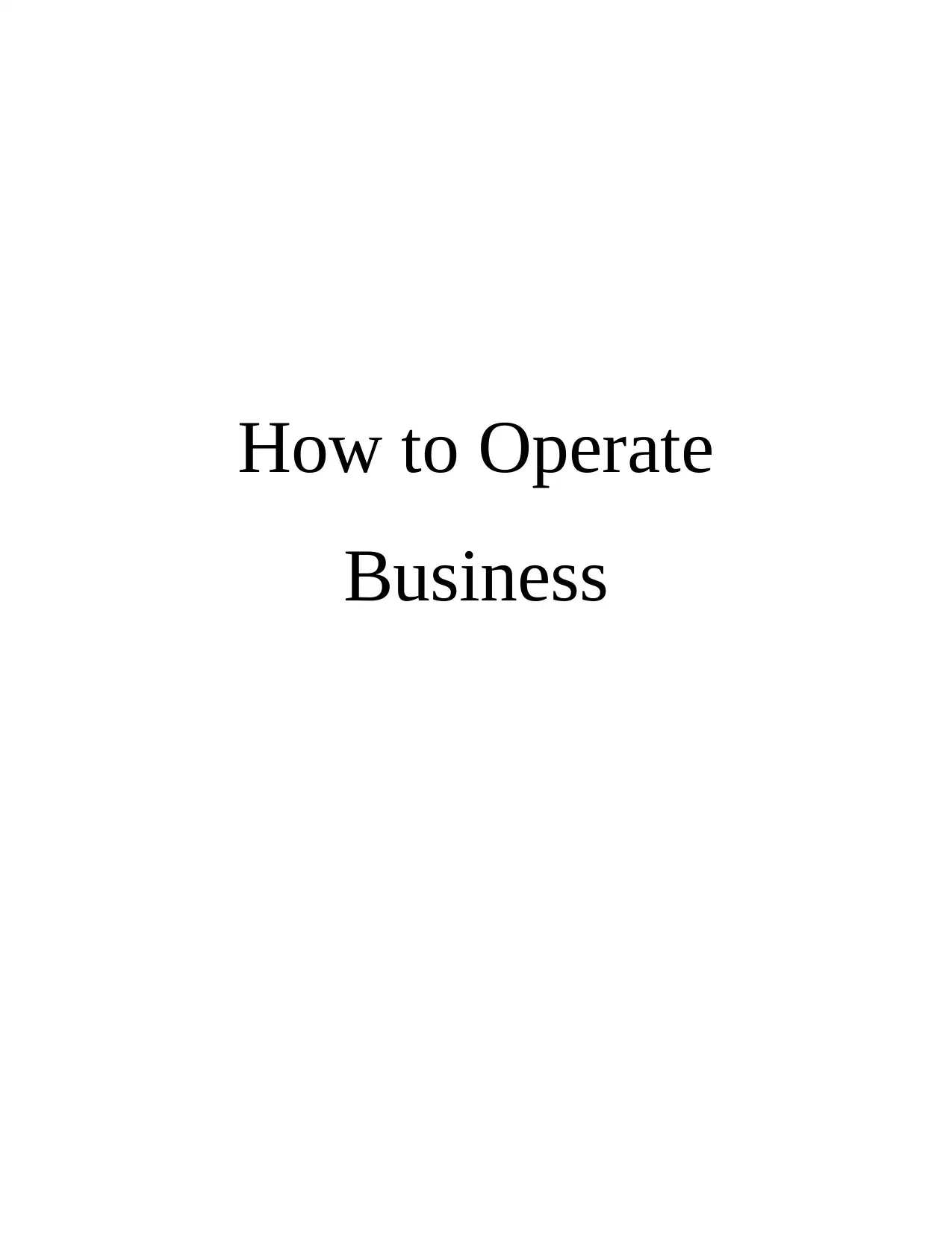
How to Operate
Business
Business
Paraphrase This Document
Need a fresh take? Get an instant paraphrase of this document with our AI Paraphraser
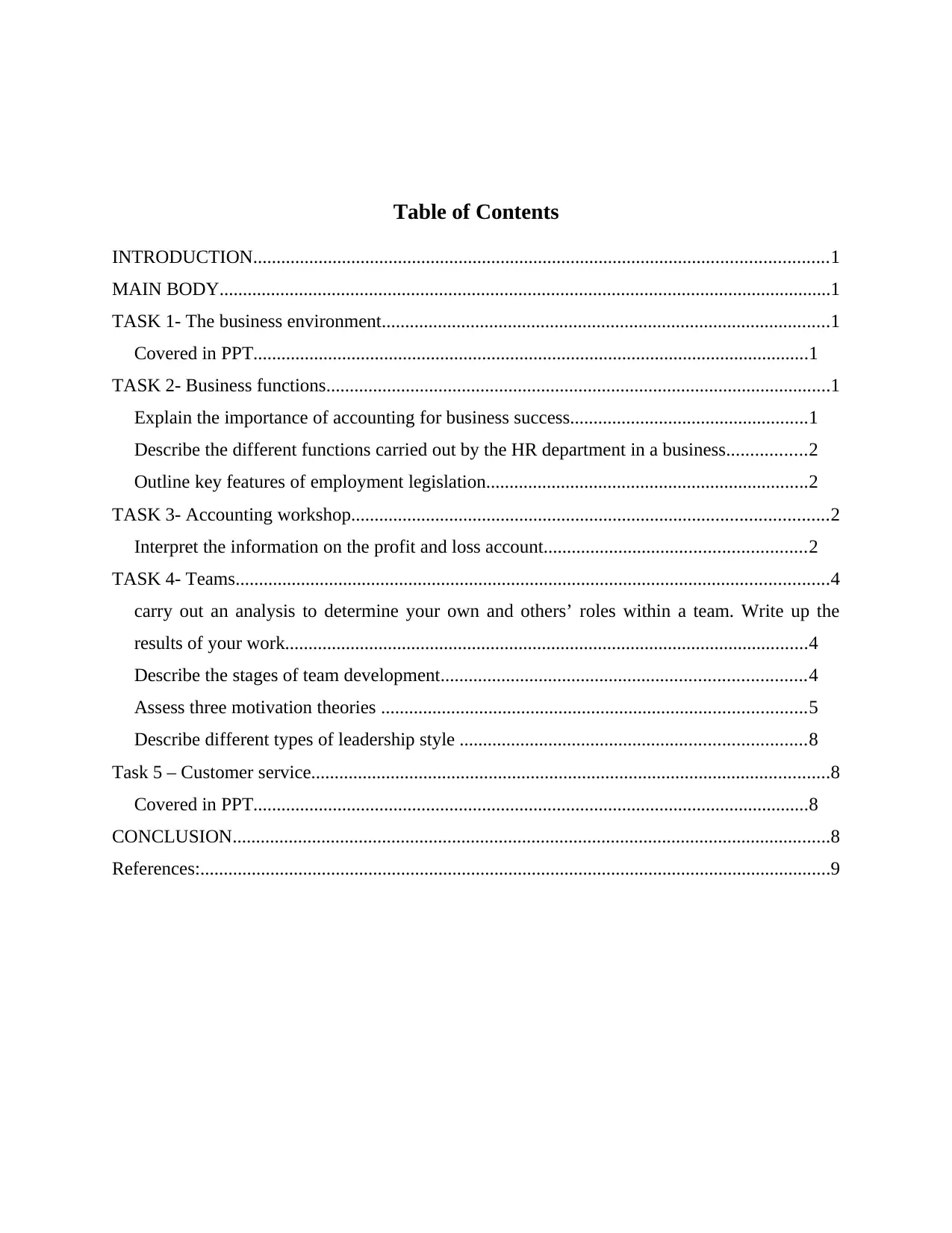
Table of Contents
INTRODUCTION...........................................................................................................................1
MAIN BODY...................................................................................................................................1
TASK 1- The business environment................................................................................................1
Covered in PPT.......................................................................................................................1
TASK 2- Business functions............................................................................................................1
Explain the importance of accounting for business success...................................................1
Describe the different functions carried out by the HR department in a business.................2
Outline key features of employment legislation.....................................................................2
TASK 3- Accounting workshop......................................................................................................2
Interpret the information on the profit and loss account........................................................2
TASK 4- Teams...............................................................................................................................4
carry out an analysis to determine your own and others’ roles within a team. Write up the
results of your work................................................................................................................4
Describe the stages of team development..............................................................................4
Assess three motivation theories ...........................................................................................5
Describe different types of leadership style ..........................................................................8
Task 5 – Customer service...............................................................................................................8
Covered in PPT.......................................................................................................................8
CONCLUSION................................................................................................................................8
References:.......................................................................................................................................9
INTRODUCTION...........................................................................................................................1
MAIN BODY...................................................................................................................................1
TASK 1- The business environment................................................................................................1
Covered in PPT.......................................................................................................................1
TASK 2- Business functions............................................................................................................1
Explain the importance of accounting for business success...................................................1
Describe the different functions carried out by the HR department in a business.................2
Outline key features of employment legislation.....................................................................2
TASK 3- Accounting workshop......................................................................................................2
Interpret the information on the profit and loss account........................................................2
TASK 4- Teams...............................................................................................................................4
carry out an analysis to determine your own and others’ roles within a team. Write up the
results of your work................................................................................................................4
Describe the stages of team development..............................................................................4
Assess three motivation theories ...........................................................................................5
Describe different types of leadership style ..........................................................................8
Task 5 – Customer service...............................................................................................................8
Covered in PPT.......................................................................................................................8
CONCLUSION................................................................................................................................8
References:.......................................................................................................................................9
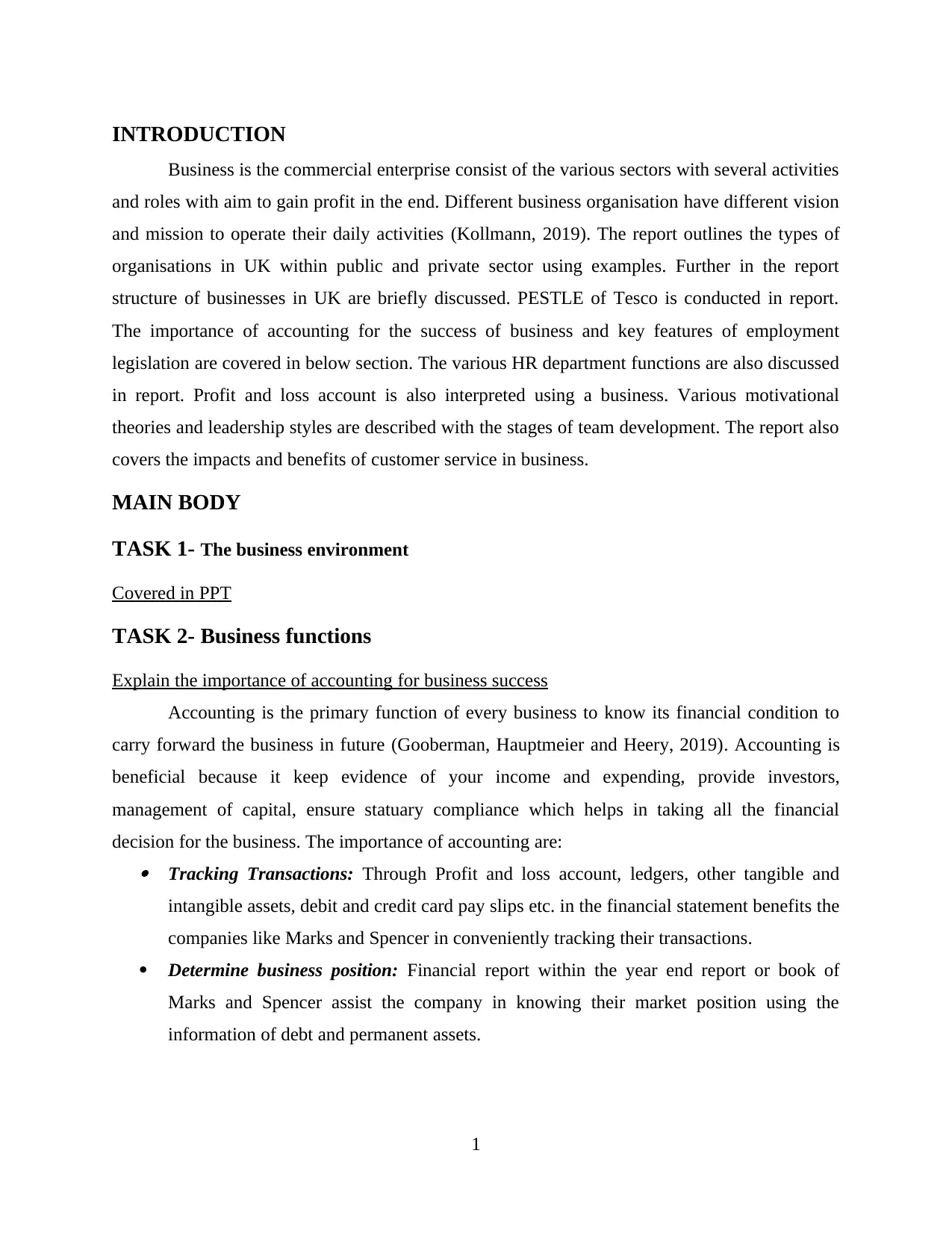
INTRODUCTION
Business is the commercial enterprise consist of the various sectors with several activities
and roles with aim to gain profit in the end. Different business organisation have different vision
and mission to operate their daily activities (Kollmann, 2019). The report outlines the types of
organisations in UK within public and private sector using examples. Further in the report
structure of businesses in UK are briefly discussed. PESTLE of Tesco is conducted in report.
The importance of accounting for the success of business and key features of employment
legislation are covered in below section. The various HR department functions are also discussed
in report. Profit and loss account is also interpreted using a business. Various motivational
theories and leadership styles are described with the stages of team development. The report also
covers the impacts and benefits of customer service in business.
MAIN BODY
TASK 1- The business environment
Covered in PPT
TASK 2- Business functions
Explain the importance of accounting for business success
Accounting is the primary function of every business to know its financial condition to
carry forward the business in future (Gooberman, Hauptmeier and Heery, 2019). Accounting is
beneficial because it keep evidence of your income and expending, provide investors,
management of capital, ensure statuary compliance which helps in taking all the financial
decision for the business. The importance of accounting are: Tracking Transactions: Through Profit and loss account, ledgers, other tangible and
intangible assets, debit and credit card pay slips etc. in the financial statement benefits the
companies like Marks and Spencer in conveniently tracking their transactions.
Determine business position: Financial report within the year end report or book of
Marks and Spencer assist the company in knowing their market position using the
information of debt and permanent assets.
1
Business is the commercial enterprise consist of the various sectors with several activities
and roles with aim to gain profit in the end. Different business organisation have different vision
and mission to operate their daily activities (Kollmann, 2019). The report outlines the types of
organisations in UK within public and private sector using examples. Further in the report
structure of businesses in UK are briefly discussed. PESTLE of Tesco is conducted in report.
The importance of accounting for the success of business and key features of employment
legislation are covered in below section. The various HR department functions are also discussed
in report. Profit and loss account is also interpreted using a business. Various motivational
theories and leadership styles are described with the stages of team development. The report also
covers the impacts and benefits of customer service in business.
MAIN BODY
TASK 1- The business environment
Covered in PPT
TASK 2- Business functions
Explain the importance of accounting for business success
Accounting is the primary function of every business to know its financial condition to
carry forward the business in future (Gooberman, Hauptmeier and Heery, 2019). Accounting is
beneficial because it keep evidence of your income and expending, provide investors,
management of capital, ensure statuary compliance which helps in taking all the financial
decision for the business. The importance of accounting are: Tracking Transactions: Through Profit and loss account, ledgers, other tangible and
intangible assets, debit and credit card pay slips etc. in the financial statement benefits the
companies like Marks and Spencer in conveniently tracking their transactions.
Determine business position: Financial report within the year end report or book of
Marks and Spencer assist the company in knowing their market position using the
information of debt and permanent assets.
1
⊘ This is a preview!⊘
Do you want full access?
Subscribe today to unlock all pages.

Trusted by 1+ million students worldwide
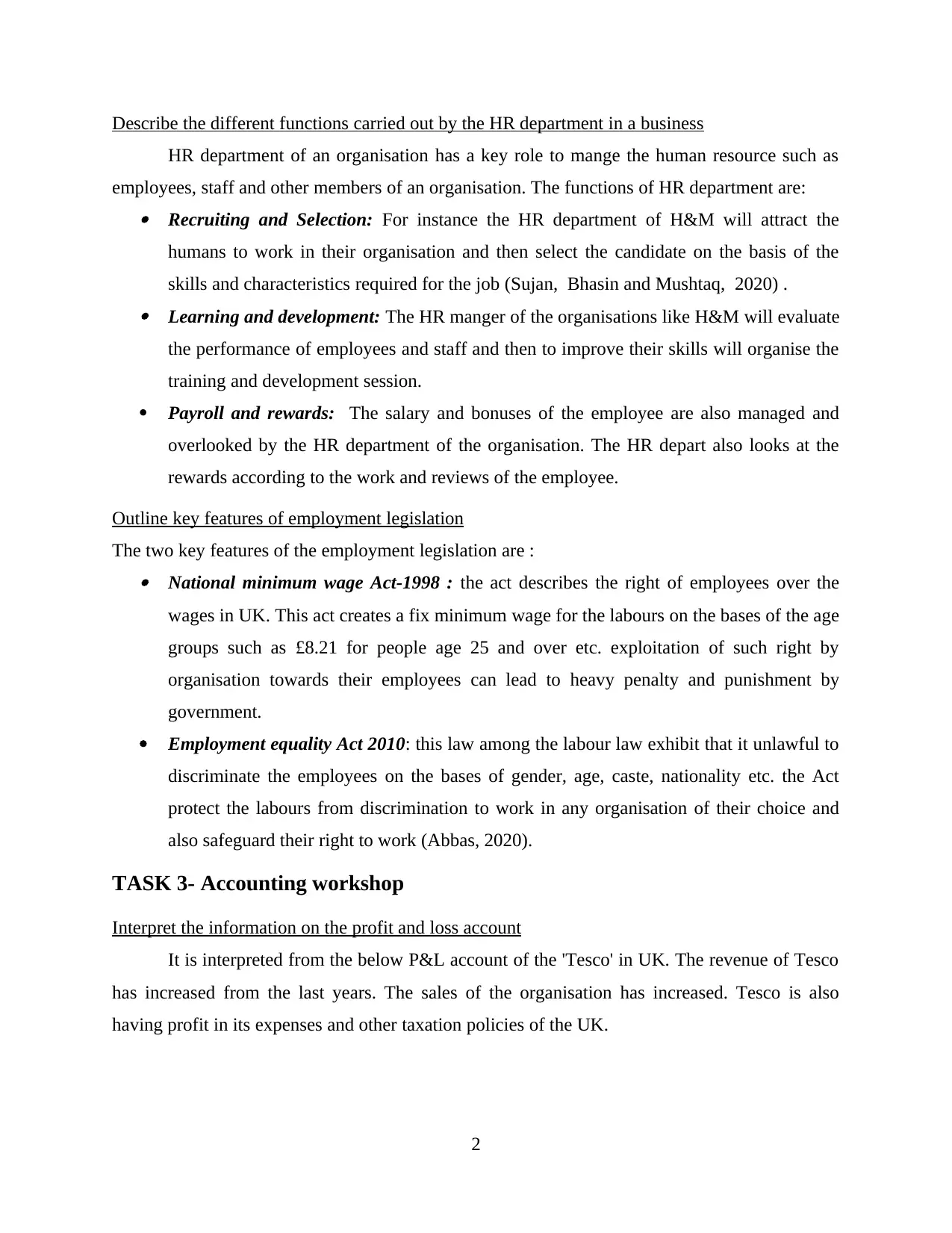
Describe the different functions carried out by the HR department in a business
HR department of an organisation has a key role to mange the human resource such as
employees, staff and other members of an organisation. The functions of HR department are: Recruiting and Selection: For instance the HR department of H&M will attract the
humans to work in their organisation and then select the candidate on the basis of the
skills and characteristics required for the job (Sujan, Bhasin and Mushtaq, 2020) . Learning and development: The HR manger of the organisations like H&M will evaluate
the performance of employees and staff and then to improve their skills will organise the
training and development session.
Payroll and rewards: The salary and bonuses of the employee are also managed and
overlooked by the HR department of the organisation. The HR depart also looks at the
rewards according to the work and reviews of the employee.
Outline key features of employment legislation
The two key features of the employment legislation are : National minimum wage Act-1998 : the act describes the right of employees over the
wages in UK. This act creates a fix minimum wage for the labours on the bases of the age
groups such as £8.21 for people age 25 and over etc. exploitation of such right by
organisation towards their employees can lead to heavy penalty and punishment by
government.
Employment equality Act 2010: this law among the labour law exhibit that it unlawful to
discriminate the employees on the bases of gender, age, caste, nationality etc. the Act
protect the labours from discrimination to work in any organisation of their choice and
also safeguard their right to work (Abbas, 2020).
TASK 3- Accounting workshop
Interpret the information on the profit and loss account
It is interpreted from the below P&L account of the 'Tesco' in UK. The revenue of Tesco
has increased from the last years. The sales of the organisation has increased. Tesco is also
having profit in its expenses and other taxation policies of the UK.
2
HR department of an organisation has a key role to mange the human resource such as
employees, staff and other members of an organisation. The functions of HR department are: Recruiting and Selection: For instance the HR department of H&M will attract the
humans to work in their organisation and then select the candidate on the basis of the
skills and characteristics required for the job (Sujan, Bhasin and Mushtaq, 2020) . Learning and development: The HR manger of the organisations like H&M will evaluate
the performance of employees and staff and then to improve their skills will organise the
training and development session.
Payroll and rewards: The salary and bonuses of the employee are also managed and
overlooked by the HR department of the organisation. The HR depart also looks at the
rewards according to the work and reviews of the employee.
Outline key features of employment legislation
The two key features of the employment legislation are : National minimum wage Act-1998 : the act describes the right of employees over the
wages in UK. This act creates a fix minimum wage for the labours on the bases of the age
groups such as £8.21 for people age 25 and over etc. exploitation of such right by
organisation towards their employees can lead to heavy penalty and punishment by
government.
Employment equality Act 2010: this law among the labour law exhibit that it unlawful to
discriminate the employees on the bases of gender, age, caste, nationality etc. the Act
protect the labours from discrimination to work in any organisation of their choice and
also safeguard their right to work (Abbas, 2020).
TASK 3- Accounting workshop
Interpret the information on the profit and loss account
It is interpreted from the below P&L account of the 'Tesco' in UK. The revenue of Tesco
has increased from the last years. The sales of the organisation has increased. Tesco is also
having profit in its expenses and other taxation policies of the UK.
2
Paraphrase This Document
Need a fresh take? Get an instant paraphrase of this document with our AI Paraphraser
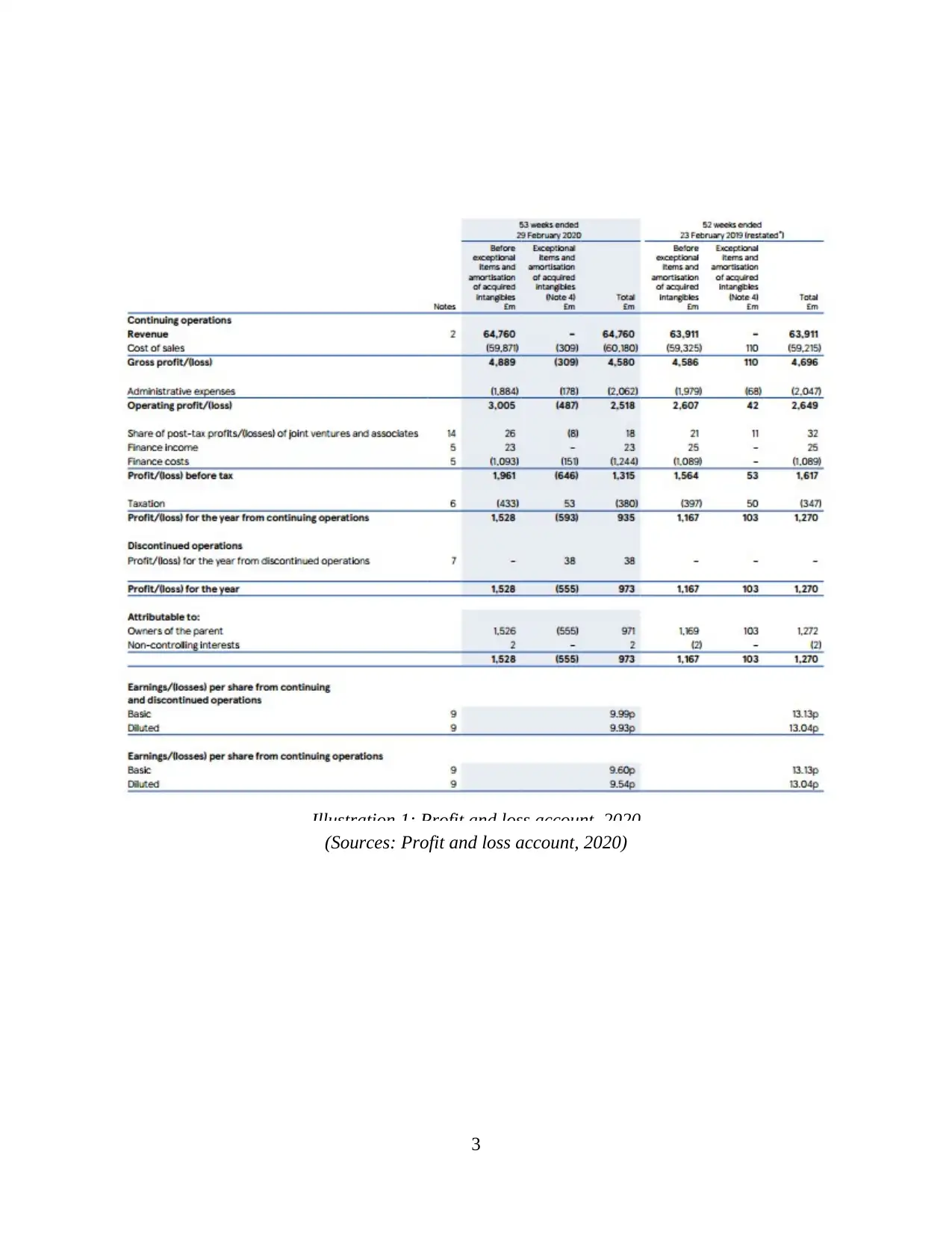
(Sources: Profit and loss account, 2020)
3
Illustration 1: Profit and loss account, 2020
3
Illustration 1: Profit and loss account, 2020
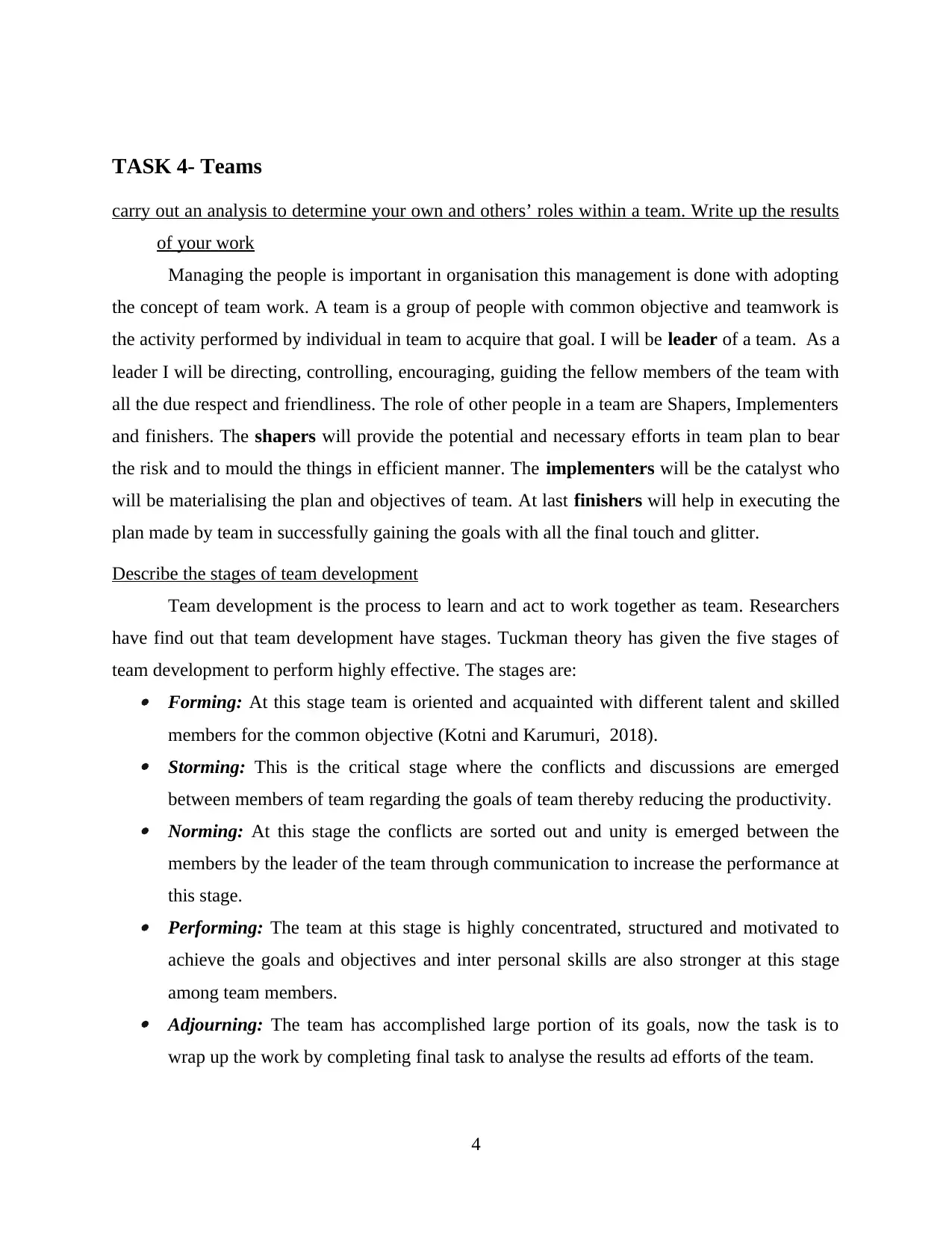
TASK 4- Teams
carry out an analysis to determine your own and others’ roles within a team. Write up the results
of your work
Managing the people is important in organisation this management is done with adopting
the concept of team work. A team is a group of people with common objective and teamwork is
the activity performed by individual in team to acquire that goal. I will be leader of a team. As a
leader I will be directing, controlling, encouraging, guiding the fellow members of the team with
all the due respect and friendliness. The role of other people in a team are Shapers, Implementers
and finishers. The shapers will provide the potential and necessary efforts in team plan to bear
the risk and to mould the things in efficient manner. The implementers will be the catalyst who
will be materialising the plan and objectives of team. At last finishers will help in executing the
plan made by team in successfully gaining the goals with all the final touch and glitter.
Describe the stages of team development
Team development is the process to learn and act to work together as team. Researchers
have find out that team development have stages. Tuckman theory has given the five stages of
team development to perform highly effective. The stages are: Forming: At this stage team is oriented and acquainted with different talent and skilled
members for the common objective (Kotni and Karumuri, 2018). Storming: This is the critical stage where the conflicts and discussions are emerged
between members of team regarding the goals of team thereby reducing the productivity. Norming: At this stage the conflicts are sorted out and unity is emerged between the
members by the leader of the team through communication to increase the performance at
this stage. Performing: The team at this stage is highly concentrated, structured and motivated to
achieve the goals and objectives and inter personal skills are also stronger at this stage
among team members. Adjourning: The team has accomplished large portion of its goals, now the task is to
wrap up the work by completing final task to analyse the results ad efforts of the team.
4
carry out an analysis to determine your own and others’ roles within a team. Write up the results
of your work
Managing the people is important in organisation this management is done with adopting
the concept of team work. A team is a group of people with common objective and teamwork is
the activity performed by individual in team to acquire that goal. I will be leader of a team. As a
leader I will be directing, controlling, encouraging, guiding the fellow members of the team with
all the due respect and friendliness. The role of other people in a team are Shapers, Implementers
and finishers. The shapers will provide the potential and necessary efforts in team plan to bear
the risk and to mould the things in efficient manner. The implementers will be the catalyst who
will be materialising the plan and objectives of team. At last finishers will help in executing the
plan made by team in successfully gaining the goals with all the final touch and glitter.
Describe the stages of team development
Team development is the process to learn and act to work together as team. Researchers
have find out that team development have stages. Tuckman theory has given the five stages of
team development to perform highly effective. The stages are: Forming: At this stage team is oriented and acquainted with different talent and skilled
members for the common objective (Kotni and Karumuri, 2018). Storming: This is the critical stage where the conflicts and discussions are emerged
between members of team regarding the goals of team thereby reducing the productivity. Norming: At this stage the conflicts are sorted out and unity is emerged between the
members by the leader of the team through communication to increase the performance at
this stage. Performing: The team at this stage is highly concentrated, structured and motivated to
achieve the goals and objectives and inter personal skills are also stronger at this stage
among team members. Adjourning: The team has accomplished large portion of its goals, now the task is to
wrap up the work by completing final task to analyse the results ad efforts of the team.
4
⊘ This is a preview!⊘
Do you want full access?
Subscribe today to unlock all pages.

Trusted by 1+ million students worldwide
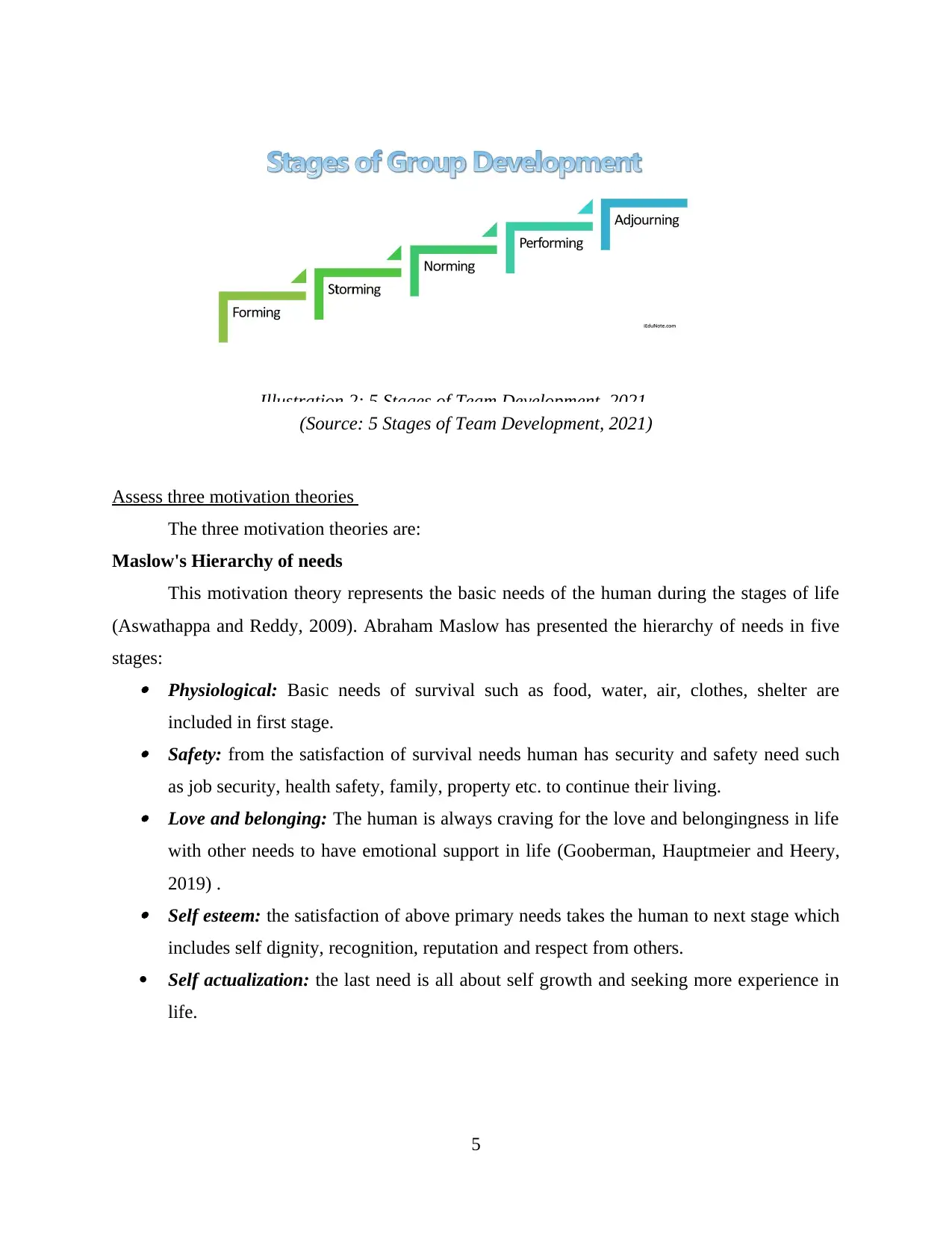
(Source: 5 Stages of Team Development, 2021)
Assess three motivation theories
The three motivation theories are:
Maslow's Hierarchy of needs
This motivation theory represents the basic needs of the human during the stages of life
(Aswathappa and Reddy, 2009). Abraham Maslow has presented the hierarchy of needs in five
stages: Physiological: Basic needs of survival such as food, water, air, clothes, shelter are
included in first stage. Safety: from the satisfaction of survival needs human has security and safety need such
as job security, health safety, family, property etc. to continue their living. Love and belonging: The human is always craving for the love and belongingness in life
with other needs to have emotional support in life (Gooberman, Hauptmeier and Heery,
2019) . Self esteem: the satisfaction of above primary needs takes the human to next stage which
includes self dignity, recognition, reputation and respect from others.
Self actualization: the last need is all about self growth and seeking more experience in
life.
5
Illustration 2: 5 Stages of Team Development, 2021
Assess three motivation theories
The three motivation theories are:
Maslow's Hierarchy of needs
This motivation theory represents the basic needs of the human during the stages of life
(Aswathappa and Reddy, 2009). Abraham Maslow has presented the hierarchy of needs in five
stages: Physiological: Basic needs of survival such as food, water, air, clothes, shelter are
included in first stage. Safety: from the satisfaction of survival needs human has security and safety need such
as job security, health safety, family, property etc. to continue their living. Love and belonging: The human is always craving for the love and belongingness in life
with other needs to have emotional support in life (Gooberman, Hauptmeier and Heery,
2019) . Self esteem: the satisfaction of above primary needs takes the human to next stage which
includes self dignity, recognition, reputation and respect from others.
Self actualization: the last need is all about self growth and seeking more experience in
life.
5
Illustration 2: 5 Stages of Team Development, 2021
Paraphrase This Document
Need a fresh take? Get an instant paraphrase of this document with our AI Paraphraser
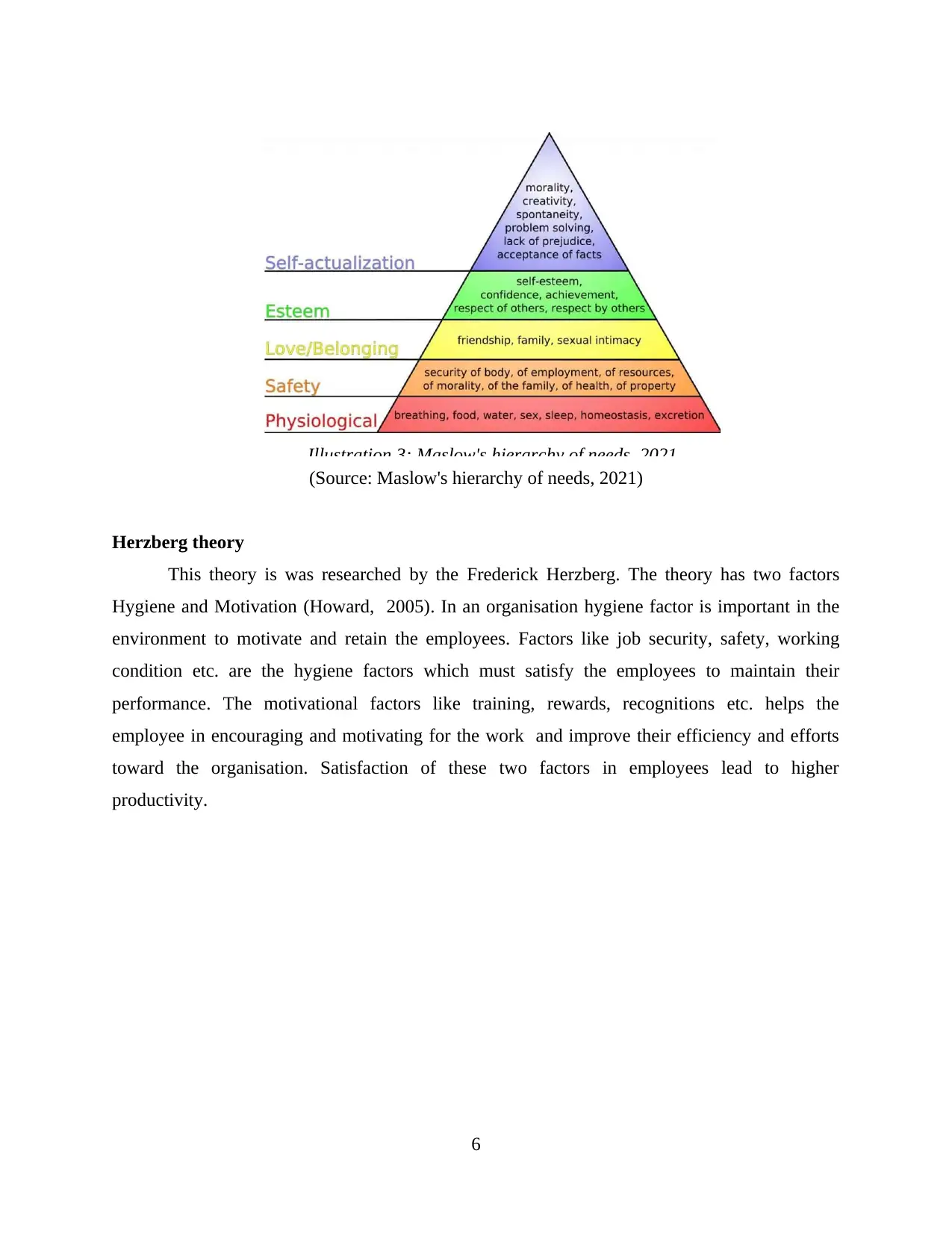
(Source: Maslow's hierarchy of needs, 2021)
Herzberg theory
This theory is was researched by the Frederick Herzberg. The theory has two factors
Hygiene and Motivation (Howard, 2005). In an organisation hygiene factor is important in the
environment to motivate and retain the employees. Factors like job security, safety, working
condition etc. are the hygiene factors which must satisfy the employees to maintain their
performance. The motivational factors like training, rewards, recognitions etc. helps the
employee in encouraging and motivating for the work and improve their efficiency and efforts
toward the organisation. Satisfaction of these two factors in employees lead to higher
productivity.
6
Illustration 3: Maslow's hierarchy of needs, 2021
Herzberg theory
This theory is was researched by the Frederick Herzberg. The theory has two factors
Hygiene and Motivation (Howard, 2005). In an organisation hygiene factor is important in the
environment to motivate and retain the employees. Factors like job security, safety, working
condition etc. are the hygiene factors which must satisfy the employees to maintain their
performance. The motivational factors like training, rewards, recognitions etc. helps the
employee in encouraging and motivating for the work and improve their efficiency and efforts
toward the organisation. Satisfaction of these two factors in employees lead to higher
productivity.
6
Illustration 3: Maslow's hierarchy of needs, 2021
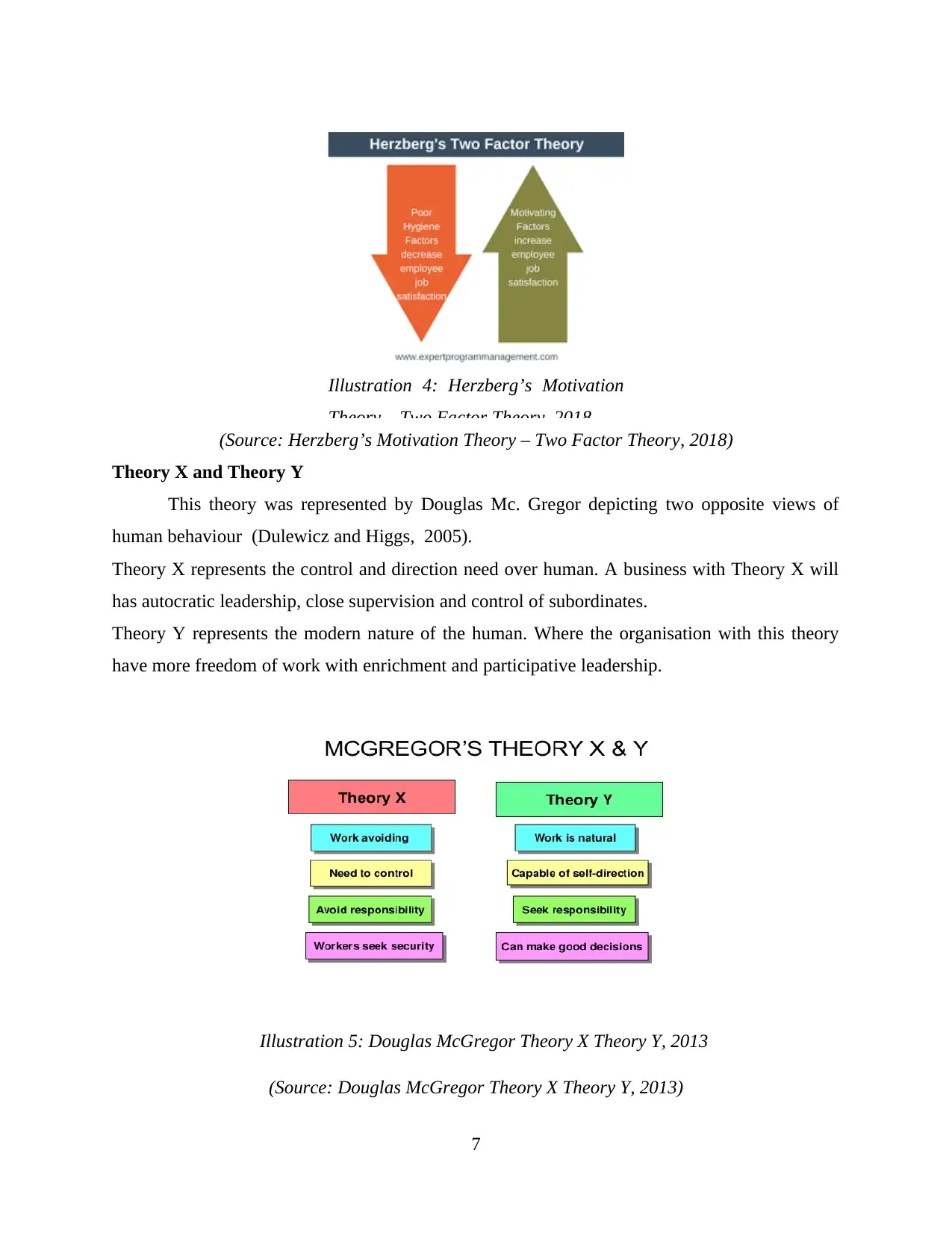
(Source: Herzberg’s Motivation Theory – Two Factor Theory, 2018)
Theory X and Theory Y
This theory was represented by Douglas Mc. Gregor depicting two opposite views of
human behaviour (Dulewicz and Higgs, 2005).
Theory X represents the control and direction need over human. A business with Theory X will
has autocratic leadership, close supervision and control of subordinates.
Theory Y represents the modern nature of the human. Where the organisation with this theory
have more freedom of work with enrichment and participative leadership.
(Source: Douglas McGregor Theory X Theory Y, 2013)
7
Illustration 5: Douglas McGregor Theory X Theory Y, 2013
Illustration 4: Herzberg’s Motivation
Theory – Two Factor Theory, 2018
Theory X and Theory Y
This theory was represented by Douglas Mc. Gregor depicting two opposite views of
human behaviour (Dulewicz and Higgs, 2005).
Theory X represents the control and direction need over human. A business with Theory X will
has autocratic leadership, close supervision and control of subordinates.
Theory Y represents the modern nature of the human. Where the organisation with this theory
have more freedom of work with enrichment and participative leadership.
(Source: Douglas McGregor Theory X Theory Y, 2013)
7
Illustration 5: Douglas McGregor Theory X Theory Y, 2013
Illustration 4: Herzberg’s Motivation
Theory – Two Factor Theory, 2018
⊘ This is a preview!⊘
Do you want full access?
Subscribe today to unlock all pages.

Trusted by 1+ million students worldwide
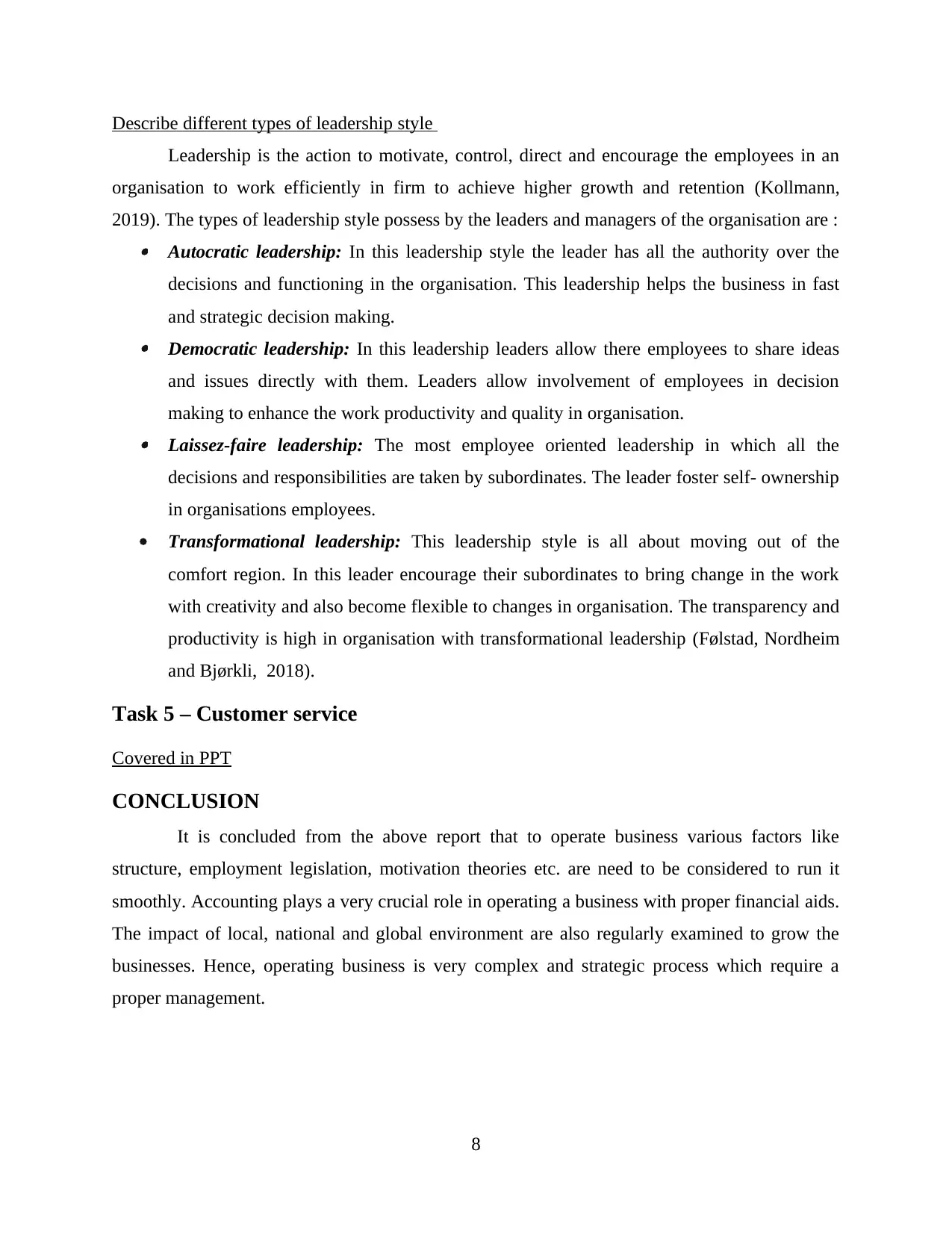
Describe different types of leadership style
Leadership is the action to motivate, control, direct and encourage the employees in an
organisation to work efficiently in firm to achieve higher growth and retention (Kollmann,
2019). The types of leadership style possess by the leaders and managers of the organisation are : Autocratic leadership: In this leadership style the leader has all the authority over the
decisions and functioning in the organisation. This leadership helps the business in fast
and strategic decision making. Democratic leadership: In this leadership leaders allow there employees to share ideas
and issues directly with them. Leaders allow involvement of employees in decision
making to enhance the work productivity and quality in organisation. Laissez-faire leadership: The most employee oriented leadership in which all the
decisions and responsibilities are taken by subordinates. The leader foster self- ownership
in organisations employees.
Transformational leadership: This leadership style is all about moving out of the
comfort region. In this leader encourage their subordinates to bring change in the work
with creativity and also become flexible to changes in organisation. The transparency and
productivity is high in organisation with transformational leadership (Følstad, Nordheim
and Bjørkli, 2018).
Task 5 – Customer service
Covered in PPT
CONCLUSION
It is concluded from the above report that to operate business various factors like
structure, employment legislation, motivation theories etc. are need to be considered to run it
smoothly. Accounting plays a very crucial role in operating a business with proper financial aids.
The impact of local, national and global environment are also regularly examined to grow the
businesses. Hence, operating business is very complex and strategic process which require a
proper management.
8
Leadership is the action to motivate, control, direct and encourage the employees in an
organisation to work efficiently in firm to achieve higher growth and retention (Kollmann,
2019). The types of leadership style possess by the leaders and managers of the organisation are : Autocratic leadership: In this leadership style the leader has all the authority over the
decisions and functioning in the organisation. This leadership helps the business in fast
and strategic decision making. Democratic leadership: In this leadership leaders allow there employees to share ideas
and issues directly with them. Leaders allow involvement of employees in decision
making to enhance the work productivity and quality in organisation. Laissez-faire leadership: The most employee oriented leadership in which all the
decisions and responsibilities are taken by subordinates. The leader foster self- ownership
in organisations employees.
Transformational leadership: This leadership style is all about moving out of the
comfort region. In this leader encourage their subordinates to bring change in the work
with creativity and also become flexible to changes in organisation. The transparency and
productivity is high in organisation with transformational leadership (Følstad, Nordheim
and Bjørkli, 2018).
Task 5 – Customer service
Covered in PPT
CONCLUSION
It is concluded from the above report that to operate business various factors like
structure, employment legislation, motivation theories etc. are need to be considered to run it
smoothly. Accounting plays a very crucial role in operating a business with proper financial aids.
The impact of local, national and global environment are also regularly examined to grow the
businesses. Hence, operating business is very complex and strategic process which require a
proper management.
8
Paraphrase This Document
Need a fresh take? Get an instant paraphrase of this document with our AI Paraphraser
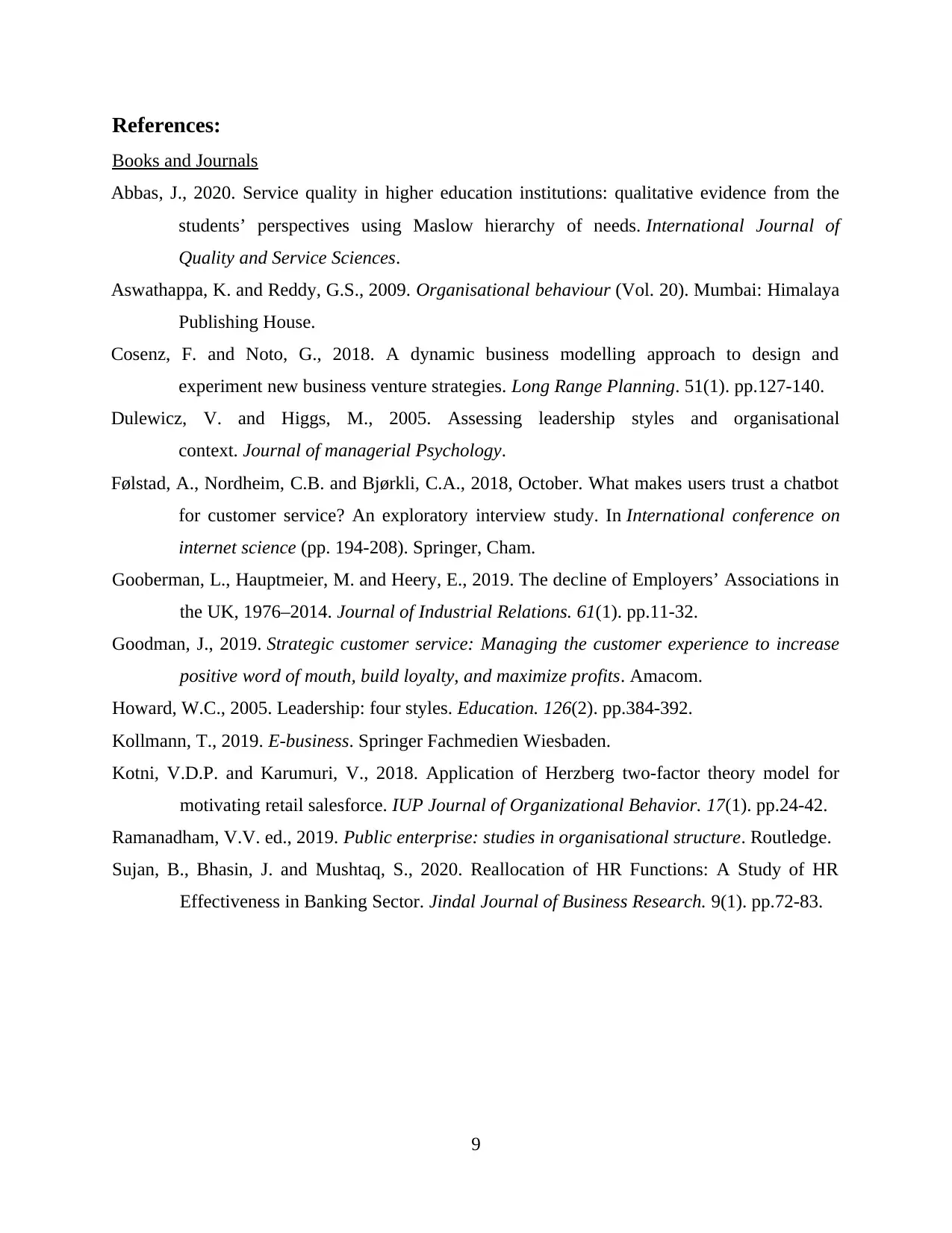
References:
Books and Journals
Abbas, J., 2020. Service quality in higher education institutions: qualitative evidence from the
students’ perspectives using Maslow hierarchy of needs. International Journal of
Quality and Service Sciences.
Aswathappa, K. and Reddy, G.S., 2009. Organisational behaviour (Vol. 20). Mumbai: Himalaya
Publishing House.
Cosenz, F. and Noto, G., 2018. A dynamic business modelling approach to design and
experiment new business venture strategies. Long Range Planning. 51(1). pp.127-140.
Dulewicz, V. and Higgs, M., 2005. Assessing leadership styles and organisational
context. Journal of managerial Psychology.
Følstad, A., Nordheim, C.B. and Bjørkli, C.A., 2018, October. What makes users trust a chatbot
for customer service? An exploratory interview study. In International conference on
internet science (pp. 194-208). Springer, Cham.
Gooberman, L., Hauptmeier, M. and Heery, E., 2019. The decline of Employers’ Associations in
the UK, 1976–2014. Journal of Industrial Relations. 61(1). pp.11-32.
Goodman, J., 2019. Strategic customer service: Managing the customer experience to increase
positive word of mouth, build loyalty, and maximize profits. Amacom.
Howard, W.C., 2005. Leadership: four styles. Education. 126(2). pp.384-392.
Kollmann, T., 2019. E-business. Springer Fachmedien Wiesbaden.
Kotni, V.D.P. and Karumuri, V., 2018. Application of Herzberg two-factor theory model for
motivating retail salesforce. IUP Journal of Organizational Behavior. 17(1). pp.24-42.
Ramanadham, V.V. ed., 2019. Public enterprise: studies in organisational structure. Routledge.
Sujan, B., Bhasin, J. and Mushtaq, S., 2020. Reallocation of HR Functions: A Study of HR
Effectiveness in Banking Sector. Jindal Journal of Business Research. 9(1). pp.72-83.
9
Books and Journals
Abbas, J., 2020. Service quality in higher education institutions: qualitative evidence from the
students’ perspectives using Maslow hierarchy of needs. International Journal of
Quality and Service Sciences.
Aswathappa, K. and Reddy, G.S., 2009. Organisational behaviour (Vol. 20). Mumbai: Himalaya
Publishing House.
Cosenz, F. and Noto, G., 2018. A dynamic business modelling approach to design and
experiment new business venture strategies. Long Range Planning. 51(1). pp.127-140.
Dulewicz, V. and Higgs, M., 2005. Assessing leadership styles and organisational
context. Journal of managerial Psychology.
Følstad, A., Nordheim, C.B. and Bjørkli, C.A., 2018, October. What makes users trust a chatbot
for customer service? An exploratory interview study. In International conference on
internet science (pp. 194-208). Springer, Cham.
Gooberman, L., Hauptmeier, M. and Heery, E., 2019. The decline of Employers’ Associations in
the UK, 1976–2014. Journal of Industrial Relations. 61(1). pp.11-32.
Goodman, J., 2019. Strategic customer service: Managing the customer experience to increase
positive word of mouth, build loyalty, and maximize profits. Amacom.
Howard, W.C., 2005. Leadership: four styles. Education. 126(2). pp.384-392.
Kollmann, T., 2019. E-business. Springer Fachmedien Wiesbaden.
Kotni, V.D.P. and Karumuri, V., 2018. Application of Herzberg two-factor theory model for
motivating retail salesforce. IUP Journal of Organizational Behavior. 17(1). pp.24-42.
Ramanadham, V.V. ed., 2019. Public enterprise: studies in organisational structure. Routledge.
Sujan, B., Bhasin, J. and Mushtaq, S., 2020. Reallocation of HR Functions: A Study of HR
Effectiveness in Banking Sector. Jindal Journal of Business Research. 9(1). pp.72-83.
9
1 out of 11
Related Documents
Your All-in-One AI-Powered Toolkit for Academic Success.
+13062052269
info@desklib.com
Available 24*7 on WhatsApp / Email
![[object Object]](/_next/static/media/star-bottom.7253800d.svg)
Unlock your academic potential
Copyright © 2020–2025 A2Z Services. All Rights Reserved. Developed and managed by ZUCOL.





